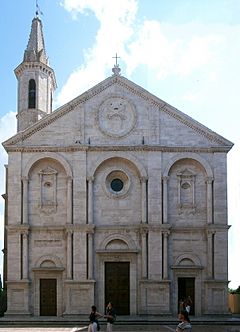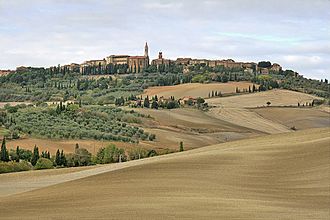Pienza facts for kids
Quick facts for kids
Pienza
|
|
|---|---|
| Comune di Pienza | |
| Country | Italy |
| Region | Toscana |
| Province | Siena (SI) |
| Frazioni | Cosona, La Foce, Monticchiello, Palazzo Massaini, Spadaletto |
| Area | |
| • Total | 122 km2 (47 sq mi) |
| Elevation | 491 m (1,611 ft) |
| Population
(December 31, 2005)
|
|
| • Total | 2,231 |
| • Density | 18.29/km2 (47.36/sq mi) |
| Demonym(s) | Pientini |
| Time zone | UTC+1 (CET) |
| • Summer (DST) | UTC+2 (CEST) |
| Postal code |
56026
|
| Dialing code | 0578 |
| Patron saint | St. Andrew the Apostle |
| Saint day | November 30 |
| Website | www.comunedipienza.it |
| Historic Centre of the City of Pienza * | |
|---|---|
 |
|
| Country | |
| Type | Cultural |
| Criteria | i, ii, iv |
| Reference | 789 |
| Region ** | Europe and North America |
| Inscription history | |
| Inscription | 1996 (20th Session) |
|
|
Pienza, a town (it: commune) in the province of Siena, in the Val d'Orcia in Tuscany (central Italy), between the towns of Montepulciano and Montalcino, is the "touchstone of Renaissance urbanism."
In 1996, UNESCO put the town his list as a World Heritage Site, and in 2004 the all valley, the Val d'Orcia, was put on the list of UNESCO's World Cultural Landscapes.
Contents
History
Pienza was rebuilt from a village called Corsignano, which was the birthplace (1405) of Aeneas Silvius Piccolomini (Italian: Enea Silvio Piccolomini), a Renaissance humanist born into an exiled Sienese family, who later became Pope Pius II. Once he became Pope, Piccolomini had the entire village rebuilt as an ideal Renaissance town. Intended as a retreat from Rome, it represents the first application of humanist urban planning concepts.The rebuilding was done by Florentine architect Bernardo Gambarelli (known as Bernardo Rossellino).
Important Places and Monuments in Pienza
Palazzo Piccolomini
The piazza is made by four buildings. The principal residence, Palazzo Piccolomini, is on the west side.
The Duomo
The Duomo (Cathedral), which dominates the center of the piazza, has a façade that is one of the earliest designed in the Renaissance manner. Artworks in the Duomo include five altar paintings from the Sienese School. The Baptistry, dedicated as usual to San Giovanni.
Palazzo Borgia
The Palazzo Borgia, on the third side of the piazza, was built as the palace to house the bishops who would travel to Pienza to attend the Pope. Inside the palace there is the Diocesan Museum, and the Museo della Cattedrale. The collection includes a lot of religious artifacts. Paintings include a 7th-century painting of Christ on the Cross (La Croce), 14th century works by Pietro Lorenzetti (Madonna with Child) and Bartolo di Fredi (Madonna della Misericordia). There are also important works from the 14th and 15th centuries, including a Madonna attributed to Luca Signorelli.
Palazzo Comunale
Across from the church is the town hall. Since Corsigniano was originally a village without a town governance, before the transformations there was no town hall. But when Corsigniano was given the status of an official city, a Palazzo Comunale was required. A third floor was added in 1599. The Palazzo Comunale was probably also designed by Rossellino.
Other buildings
- Ammannati Palace
- The Gonzaga Palace
- The Palazzo del Cardinale Atrebatense
- The Pieve of Corsignano, in the neighbourhood, is one of the most important Romanesque monuments of the area.
Related pages
Images for kids
See also
 In Spanish: Pienza para niños
In Spanish: Pienza para niños





